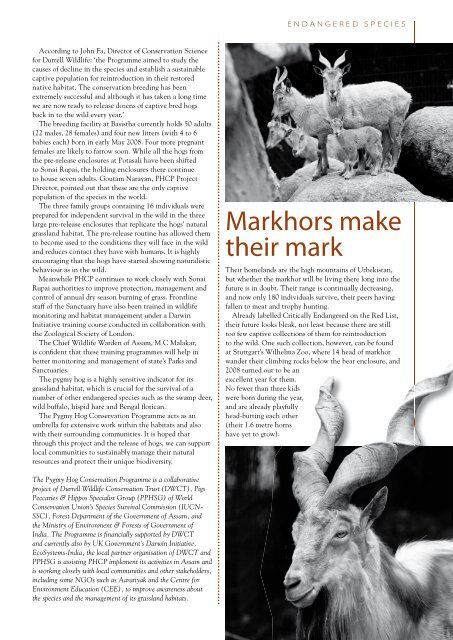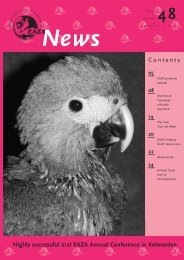EAZA NEWS 65 - European Association of Zoos and Aquaria
EAZA NEWS 65 - European Association of Zoos and Aquaria
EAZA NEWS 65 - European Association of Zoos and Aquaria
You also want an ePaper? Increase the reach of your titles
YUMPU automatically turns print PDFs into web optimized ePapers that Google loves.
According to John Fa, Director <strong>of</strong> Conservation Science<br />
for Durrell Wildlife: ‘the Programme aimed to study the<br />
causes <strong>of</strong> decline in the species <strong>and</strong> establish a sustainable<br />
captive population for reintroduction in their restored<br />
native habitat. The conservation breeding has been<br />
extremely successful <strong>and</strong> although it has taken a long time<br />
we are now ready to release dozens <strong>of</strong> captive bred hogs<br />
back in to the wild every year.’<br />
The breeding facility at Basistha currently holds 50 adults<br />
(22 males, 28 females) <strong>and</strong> four new litters (with 4 to 6<br />
babies each) born in early May 2008. Four more pregnant<br />
females are likely to farrow soon. While all the hogs from<br />
the pre-release enclosures at Potasali have been shifted<br />
to Sonai Rupai, the holding enclosures there continue<br />
to house seven adults. Goutam Narayan, PHCP Project<br />
Director, pointed out that these are the only captive<br />
population <strong>of</strong> the species in the world.<br />
The three family groups containing 16 individuals were<br />
prepared for independent survival in the wild in the three<br />
large pre-release enclosures that replicate the hogs’ natural<br />
grassl<strong>and</strong> habitat. The pre-release routine has allowed them<br />
to become used to the conditions they will face in the wild<br />
<strong>and</strong> reduces contact they have with humans. It is highly<br />
encouraging that the hogs have started showing naturalistic<br />
behaviour as in the wild.<br />
Meanwhile PHCP continues to work closely with Sonai<br />
Rupai authorities to improve protection, management <strong>and</strong><br />
control <strong>of</strong> annual dry season burning <strong>of</strong> grass. Frontline<br />
staff <strong>of</strong> the Sanctuary have also been trained in wildlife<br />
monitoring <strong>and</strong> habitat management under a Darwin<br />
Initiative training course conducted in collaboration with<br />
the Zoological Society <strong>of</strong> London.<br />
The Chief Wildlife Warden <strong>of</strong> Assam, M C Malakar,<br />
is confi dent that these training programmes will help in<br />
better monitoring <strong>and</strong> management <strong>of</strong> state’s Parks <strong>and</strong><br />
Sanctuaries.<br />
The pygmy hog is a highly sensitive indicator for its<br />
grassl<strong>and</strong> habitat, which is crucial for the survival <strong>of</strong> a<br />
number <strong>of</strong> other endangered species such as the swamp deer,<br />
wild buffalo, hispid hare <strong>and</strong> Bengal fl orican.<br />
The Pygmy Hog Conservation Programme acts as an<br />
umbrella for extensive work within the habitats <strong>and</strong> also<br />
with their surrounding communities. It is hoped that<br />
through this project <strong>and</strong> the release <strong>of</strong> hogs, we can support<br />
local communities to sustainably manage their natural<br />
resources <strong>and</strong> protect their unique biodiversity.<br />
The Pygmy Hog Conservation Programme is a collaborative<br />
project <strong>of</strong> Durrell Wildlife Conservation Trust (DWCT), Pigs<br />
Peccaries & Hippos Specialist Group (PPHSG) <strong>of</strong> World<br />
Conservation Union’s Species Survival Commission (IUCN-<br />
SSC), Forest Department <strong>of</strong> the Government <strong>of</strong> Assam, <strong>and</strong><br />
the Ministry <strong>of</strong> Environment & Forests <strong>of</strong> Government <strong>of</strong><br />
India. The Programme is fi nancially supported by DWCT<br />
<strong>and</strong> currently also by UK Government’s Darwin Initiative.<br />
EcoSystems-India, the local partner organisation <strong>of</strong> DWCT <strong>and</strong><br />
PPHSG is assisting PHCP implement its activities in Assam <strong>and</strong><br />
is working closely with local communities <strong>and</strong> other stakeholders,<br />
including some NGOs such as Aaranyak <strong>and</strong> the Centre for<br />
Environment Education (CEE), to improve awareness about<br />
the species <strong>and</strong> the management <strong>of</strong> its grassl<strong>and</strong> habitats.<br />
endangered species<br />
Markhors make<br />
their mark<br />
Their homel<strong>and</strong>s are the high mountains <strong>of</strong> Uzbekistan,<br />
but whether the markhor will be living there long into the<br />
future is in doubt. Their range is continually decreasing,<br />
<strong>and</strong> now only 180 individuals survive, their peers having<br />
fallen to meat <strong>and</strong> trophy hunting.<br />
Already labelled Critically Endangered on the Red List,<br />
their future looks bleak, not least because there are still<br />
too few captive collections <strong>of</strong> them for reintroduction<br />
to the wild. One such collection, however, can be found<br />
at Stuttgart’s Wilhelma Zoo, where 14 head <strong>of</strong> markhor<br />
w<strong>and</strong>er their climbing rocks below the bear enclosure, <strong>and</strong><br />
2008 turned out to be an<br />
excellent year for them. them.<br />
No fewer than three kids<br />
were born during the year,<br />
<strong>and</strong> are already playfully<br />
head-butting each other<br />
(their (their 1.6 metre horns<br />
have yet to grow).<br />
11

















